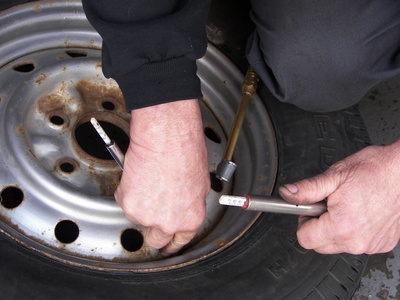
Cars are complex pieces of machinery with many different interdependent systems. The suspension system itself is one prime example of interdependency; if any one component fails, the entire system stops working. Vibrations are a type of "cyclic" failure, wherein the same problem is expressed over and over again. Cyclic suspension failures always indicate that something that should be smoothly spinning isn't.
Very few wheels have perfect balance from the factory. Tiny imperfections in machining or casting, variations in metal density and even small dents in the wheel can cause it to go out of balance. Manufacturers and garages use machines to determine which part of the wheel is the lightest, and install soft lead weights to bring that side up to spec. Over time, these weights can fatigue and fall off, throwing the wheel back out of balance and causing vibration that may be completely absent at low speed but quite pronounced at anything over 30 mph.
Driveshafts require weights to bring them back into balance, too, but these weights are usually welded on. Driveshaft imbalances are usually the result of a dent or bent shaft, which throws the mass off-center and causes vibration. This can apply to front-wheel drive cars, but generally only happens to rear-wheel, all-wheel or four-wheel drive vehicles. While not generally considered part of the suspension (it technically is since it moves with the wheels), driveshaft vibration can easily mimic the usual suspension problems.
Tires have metal reinforcing belts inside which, when they snap, will cause a weak spot in the tire's tread. These weak spots will inevitably manifest as bubbles, which cause a high spot on the tire and vibration when they touch the ground. Flat-spots are the opposite of bubbles and are usually caused by locking the brakes. Tire deformations differ from other kinds of vibration in that they will be present regardless of vehicle speed. At low speed, the bumping will be slower and longer; at high speed it will come and go rapidly.
Bent or worn out steering end links and steering shafts may cause vibration at speed. This condition differs from other vibrations in that the vibration is more side-to-side than up-and-down. If you experience this sort of vibration stop the car, have it towed and have it repaired immediately. This condition could also indicate that the suspension is severely out of alignment; you won't know until you get it checked.
Worn wheel bearings will first manifest themselves with a low, intermittent grumbling or grinding, which will over time become a pronounced vibration that increases in pitch and frequency with speed. Audibly growling bearings aren't necessarily an immediate danger, but you should replace them as soon as you begin to feel vibration or hear a squealing associated with the grumble.